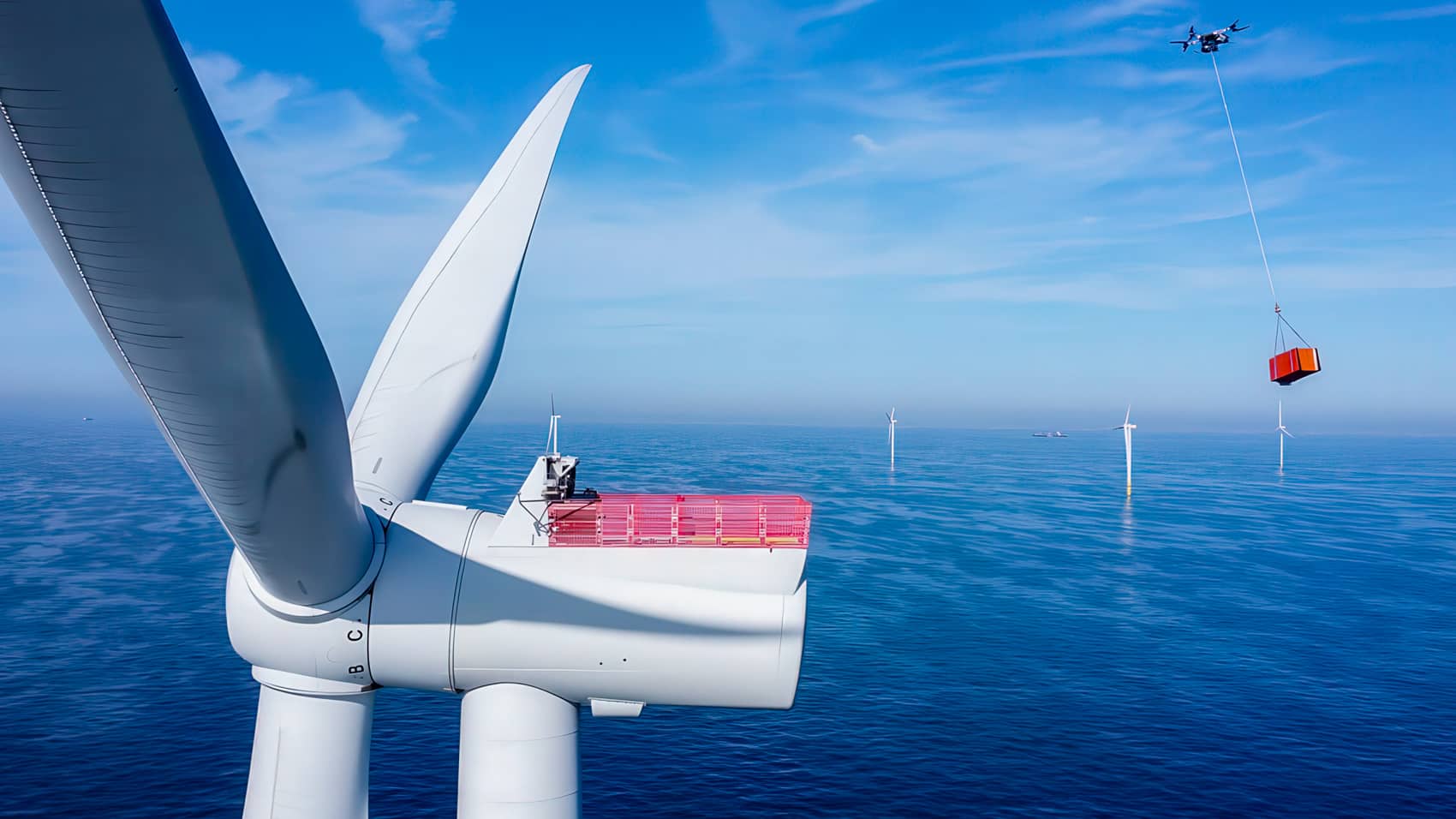Revolutionizing Offshore Wind Farm Logistics with Giant Drones
Giant drones are making waves in the renewable energy sector by transforming how offshore wind farm logistics are managed. Serving as aerial couriers, they deliver crucial equipment and safety gear straight to wind turbines, vastly enhancing speed, safety, and environmental sustainability.
Giant Drones: The New Face of Wind Farm Logistics
Previously, transporting equipment to the top of wind turbines demanded chartering sizeable ships, employing cranes for perilous lifts, and often involved significant waiting times due to weather conditions and crew availability. Now, fleets of giant cargo drones complete these tasks in just minutes, moving from ship to turbine as if they were massive mechanical bees.
- Ørsted, known as the Amazon of wind energy, has partnered with the UK drone operator Skylift to initiate the world’s largest offshore drone delivery program, accomplishing over 550 flights and servicing more than 400 turbines, sometimes located up to 75 miles from the shore.
- The FlyingBasket drones effectively transport up to 70 kilograms of cargo (equivalent to the weight of a washing machine) from ship decks directly to turbine nacelles, eliminating any need for cranes or dangerous climbs.
Faster and Greener: A Comparison
| Old Method (Ships & Cranes) | New Drone Delivery |
|---|---|
| Hundreds of man-hours per operation | 4 minutes per delivery |
| Multiple lifts and risky crew climbs | Direct, remote aerial delivery |
| Turbines must be shut down for safety | No shutdowns—work continues |
| High carbon emissions, high costs | Lower emissions, less fuel, less cost |
Drones enable the delivery of boxes to the tops of turbines—standing over 100 meters tall—at speeds 10 to 15 times faster than traditional methods, thereby enhancing efficiency and significantly cutting emissions and fuel use.
Key Features of Giant Drones
- Built for Heavy Lifting: FlyingBasket and similar drones are engineered to hoist between 70 and 220 pounds, with an even greater lifting capacity anticipated in future models.
- Advanced Technology: They are guided by GPS, resilient to harsh weather, and equipped with multiple fail-safes for reliable offshore operation, including return-to-home protocols and redundant motor and battery systems.
- Multi-role Flexibility: These platforms excel in various roles, including powerline and pipeline inspections, emergency supply and medical deliveries, search and rescue missions, and heavy-lift cinematography.
Real-World Achievements and Stories
The Hornsea project, the world’s largest operational wind farm located off Yorkshire’s coast, has successfully utilized drones for delivering fresh evacuation and safety gear thanks to Ørsted and Skylift cooperation. Previously, using traditional methods required shutting down turbines for hours, costing thousands in lost energy production. Drone deliveries, on the other hand, ensure continuous operation.
Ørsted’s Deputy CEO, Rasmus Errboe, emphasized that deploying drones at Borssele 1 & 2 will enhance safety, reduce carbon emissions, and lower operation costs, thus improving the commercial fundamentals of offshore wind energy for various stakeholders.
The Human and Global Perspective
- Enhanced Safety: Drones limit personnel exposure to the hazards of offshore environments and heavy lifting, taking on the most dangerous roles themselves.
- Lower Emissions: By cutting down the use of supply ships for regular cargo, wind farm operators can significantly reduce their carbon footprint, contributing to cleaner energy.
- Inspiring Industry Change: Real life stories of offshore crew members show excitement about cutting-edge technology in action, signaling a new era for shipping and logistics at sea.
- Tech for a Better Future: Drones, previously stereotyped as toys or military tools, are becoming invaluable instruments for a safer, greener future.
Prominent Drone Models and Specifications
| Drone Model | Max Payload | Range | Use Case |
|---|---|---|---|
| FlyingBasket FB3 | 70 kg | Up to 25 km | Offshore wind cargo, construction |
| DJI FlyCart 30 | 30 kg | Up to 16 km | Delivery, logistics |
| GRIFF 300 | 225 kg | Up to 30 min | Heavy industry, emergency response |
| Freefly Flying Sun | Custom | Custom | Lighting, special applications |
Looking Ahead: Future Trends
- Larger and More Intelligent: Emerging airframes promise heavier lifting capacities, hybrid power systems, and more autonomous operations, decreasing the need for human pilots.
- Expanding Applications Beyond Wind Farms: Drones are poised to handle railway repairs, remote construction, disaster relief, and even emergency oceanic deliveries.
- AI-Enabled Fleets: Future drone fleets will be capable of self-scheduling, autonomous loading, and battery swapping with minimal intervention.
Common Questions and Misconceptions
- Size and Capability: Industrial cargo drones now routinely lift 50–200 kg, handling most requirements of wind farm operations.
- Safety: Offshore drones incorporate redundant systems for added safety, comparable to or even exceeding the safety of traditional methods.
- Sustainability: Each drone mission eliminates the necessity for boat trips, crane operations, and associated emissions, contributing to massive carbon savings.
- Employment Impact: While drones modify job roles, they also expand opportunities in piloting, fleet management, and high-tech maintenance.
Beyond Machines: Our Commitment
At [Your Drone Company], we transcend mere machine operation by fully investing our passion into modernizing industries for sustainable growth. Our experienced engineers and pilots are dedicated professionals who enjoy leveraging new challenges to advance technology’s potential. We focus on creating innovative partnerships with energy leaders, emphasizing a collaborative approach through custom flight planning and continuous fleet monitoring.
Our proudest achievements involve ensuring engineers return home safely and maintaining operational turbines without adding emissions. Technology is more than just data; it’s a mission for a cleaner world.
Tips and Recommendations
- Incorporate drone delivery into the early design phases of wind farms or logistics plans to maximize cost efficiency and operational flexibility.
- Stay informed about evolving regulatory landscapes offshore and choose providers with up-to-date certifications and safety audits.
- Consider environmental resilience—drones must withstand harsh offshore conditions.
Giant drones have moved from science fiction into real-world applications, providing essential support to wind farms by reducing risks and carbon emissions while enhancing reliability. As renewable energy becomes crucial, these sky couriers emerge as unsung heroes, showcasing the synergy of technology and human innovation.













